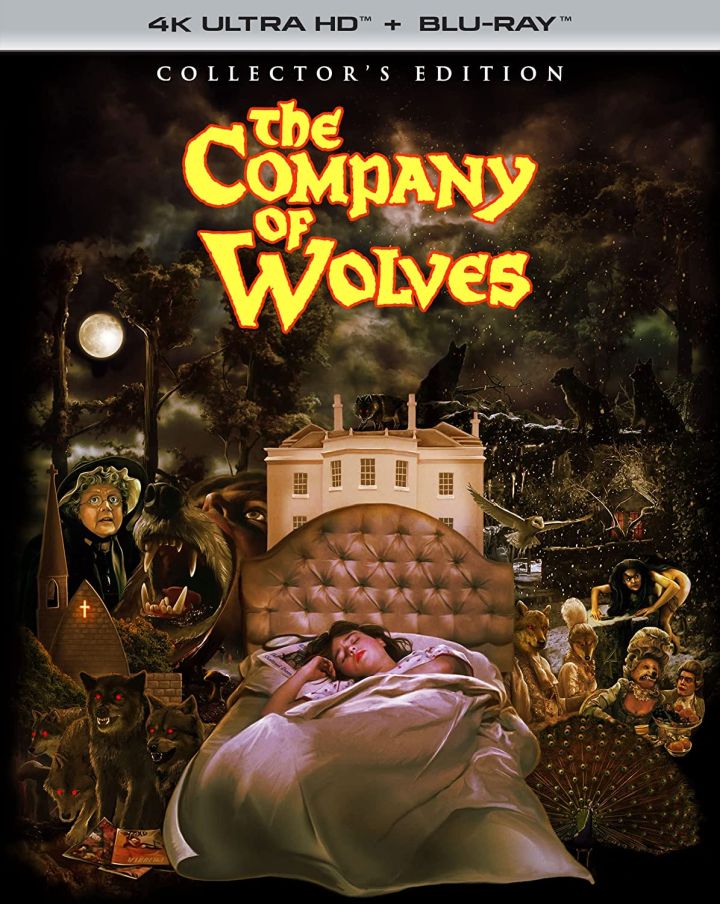
The Company of Wolves (1984) is only kind of a werewolf movie, in that werewolves in the 20th century took the position of terror that wolves themselves had in folklore. The wolf in “Little Red Riding Hood” is not a werewolf, but just a beast who can talk. He can talk because he is not just a wolf, but also a man, or representative of one. Werewolves square that folklore circle.
And though the wolves in Company of Wolves are generally werewolves, they serve the same function as the wolf the folk story. They are the male id unleashed. Rapacious instinct. Possessive lust. It’s symbolically powerful, and The Company of Wolves is replete with powerful symbols. What it lacks is a great cohesive story.
Our tale begins in the modern day with Rosaleen, a girl who will not wake up. Her sister is pounding on the door, calling her a pest, and complaining that she has stolen her lipstick. And she has, because this young girl wants to hasten womanhood, and she does so in her dream. The symbolism comes heavy and fast. In the dream the big sister is lost in the Woods. This is the capital-W “Woods: from every terrifying fairy story. The toys from Rosaleen’s bedroom are life size here, and leaping out at the older, her childhood chasing her down the path to her grown-up doom. Be not surprised there’s a wolf at the end of that dream.
The older sister disposed of, it’s Rosaleen who must take up the family’s position of budding young woman. She’s pursued by local boys and coddled by her grandmother (Angela Lansbury) who is filled with old woman’s wisdom. Always stay on the path in the forest. Never eat a windfall apple. Never trust a man whose eyebrows meet.
This gets illustrated by a story, as many of the lessons in the film are illustrated with stories. Most are about young women getting involved with men who are not what they seem. The Company of Wolves is not any kind of straight-forward narrative. It’s a girl’s dream, which gives it the excuse to get all “dream-like” in its narrative. This means occasionally fantastic, grotesque and horrifying imagery. This means a story that doesn’t feel like it has to make much sense.
Rosaleen is interested in growing up but doesn’t find any likely candidates to facilitate her maturity. There’s a boy in love with her in town, but he’s played by a goony-looking kid who’s at once too eager and too clumsy. What Rosaleen (played with preternatural poise by a then 12-year-old Sarah Patterson) wants is a man. And she eventually finds one, and she doesn’t even seem to notice his eyebrows meet in the middle.
Is The Company of Wolves a feminist film? Rather plainly, I’d say that’s the case. In one of the stories about an aristocrat whose wedding is interrupted by the peasant he’d impregnated and discarded, relationship power dynamics are explicitly (and rather clunkily) brought up. The mistreatment of women by men is a common theme. And there isn’t anything like a good man in the entire cast of characters. But most of the women are fairly useless, as well. And the commitment to a theme is muddle by some of the more generic story elements, with wolf hunts and walks in the forest.
What cannot be said is that the production design is muddled. Headed by Anton Furst, it so impressed Stanley Kubrick that he brought the designer on for Full Metal Jacket. There’s no pretending that the film isn’t shot on studio backlots and sound stages, but the woods and the sparse medieval village it surrounds look at once real and heightened for a fairy tale. It doesn’t look particularly high budget, and thought the misty quality maintains the dream-like atmosphere, it doesn’t make for a reference quality 4K experience.
The Company of Wolves itself is an experience. I don’t know if it’s one I’d readily recommend. It looks like a horror film, but really isn’t one, despite some impressively gory sequences. It has a poetic and rambling dream-like feel that is attractive, but I don’t know if it fully coalesces into a coherent statement. For the collectors of unique cinematic images and atmospheres, The Company of Wolves has more than its share. But when the mists clear, they don’t reveal as much as one would hope, which is a shame.
The Company of Wolves has been released on 4K UHD by Shout Factory. The release includes a 4K UHD disc and a standard Blu-ray disc. Extras on the 4K include two commentary tracks, one by director Neil Jordan and another by producer Chris Brown and special effects makeup artist Christopher Tucker.
Both commentaries are also included on the Blu-ray, which also has a still gallery and a pair of video extras, new for this release: “Where the Fairy Tales End: Scoring The Company of Wolves” (19 min), an interview with composer George Fenton; and “Alice in Dreamland” (6 min), an interview with actress Georgia Slowe.